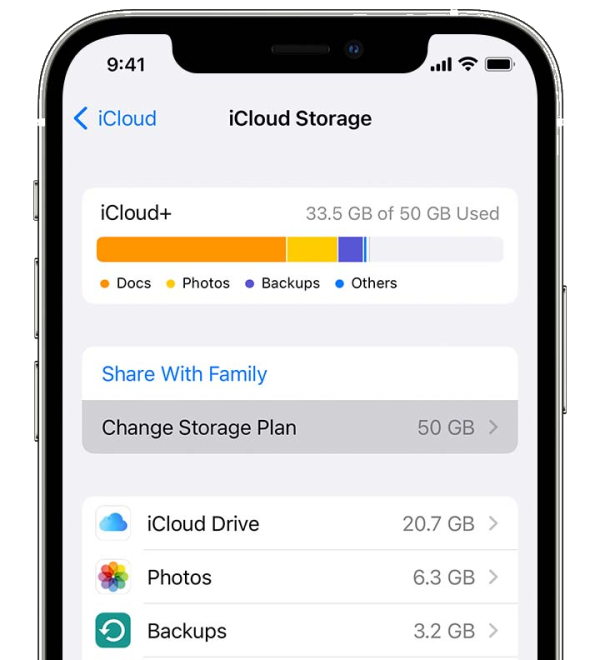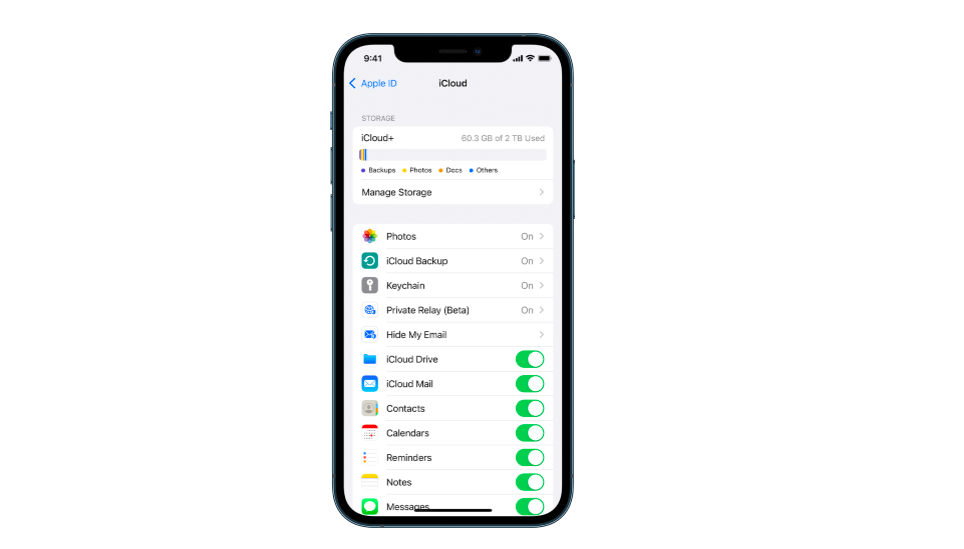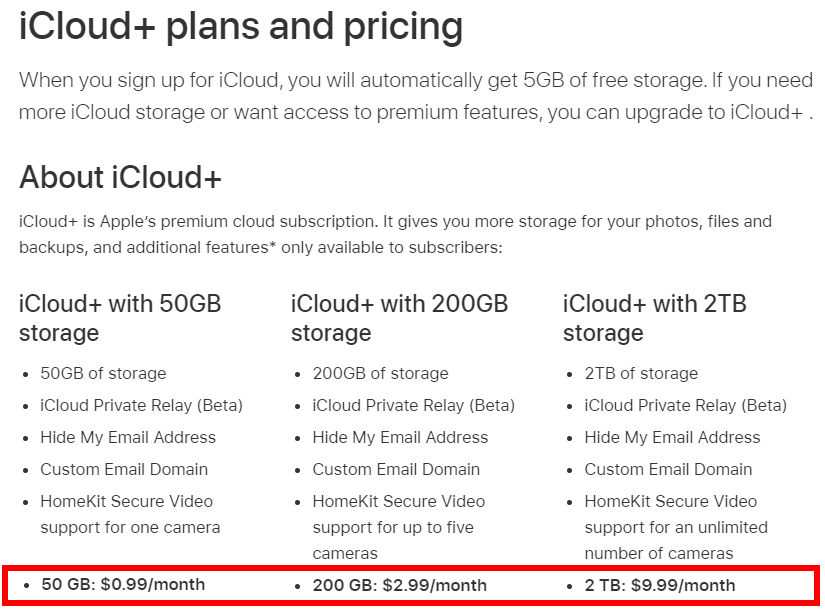Apple gives you 5GB of free space in its native cloud storage product, iCloud. But that will quickly fill up! What do you do when all that space is filled up? Here I show you how to free up iCloud Storage on your iPhone.
If you have an iPhone, chances are you’ve encountered the much dreaded “iCloud Storage Is Full” notification.
This can be particularly confusing for users who didn’t even know they’ve been using something called iCloud Storage, let alone filling it up!

Apple gives all of its customers 5GB of free space in its native cloud storage product, iCloud. But what do you do when all that space is filled up?
The good news is, that there are a few different ways to fix this problem.
But before we get into how you can get rid of these annoying notifications and prevent the problem from coming back, let’s take a look at what exactly iCloud Storage is and why you’re being informed that it’s full.
Summary: How can you free up iCloud storage on your iPhone?
- If you keep getting the “iCloud Storage Is Full” notification, it’s a warning that you need to clear up storage in iCloud.
- There are three main ways to do this: you can delete files from iCloud, delete old backups, or pay for more space.
- You can also ignore the notification by closing it, but obviously, this doesn’t fix the problem itself.
What Is iCloud and How Does It Work?
Apple may have revolutionized the industry when it comes to intuitive, user-friendly tech products, but the company does seem to love making things unnecessarily complicated when it comes to product variety.
On your iPhone alone, you likely have the following: iCloud Storage, iCloud Backup, iCloud Drive, iCloud Photo Library, and My Photo Stream.
So, which of these exactly is full, and why?
If all of this makes you want to give up and throw your iPhone out the window, you’re not alone. Let’s break it down and make things a bit simpler.
iCloud Storage
In today’s digital age, cloud services have become an essential part of our daily lives.
Whether it’s storing our photos on Google Photos or using Google Drive for document sharing and collaboration, cloud services have made our lives easier.
With the increasing demand for web hosting, it has become more important than ever to have access to reliable and affordable hosting solutions.
Additionally, managing email attachments and configuring system preferences has also become an integral part of our online activities.
By using these tools and services effectively, we can ensure that we make the most of the internet’s potential and streamline our digital lives.
All iPhones come with 5GB of free iCloud storage. This is Apple’s native cloud storage solution.
Why have a cloud storage system on your phone? Well, look at it this way: how many times have you almost dropped your phone into the toilet? Or fumbled it while snapping a picture at an awkward angle?
Damage or destruction of your device will also destroy any files or data that are stored locally on the device.
However, if you’ve backed up all your important files to the cloud, then you can rest easy knowing that it’s safe no matter how clumsy or accident-prone you are.
iCloud Backup
For many smartphone users, text messages, photo libraries, and video clips are some of the most important and personal data stored on their devices.
Text messages can contain important information and sentimental conversations, while photo libraries and video clips capture memories that are irreplaceable.
It’s important to regularly back up this data to ensure that it’s not lost in the event of a device failure, accidental deletion, or other issue.
Fortunately, there are several options available for backing up text messages, photo libraries, and video clips, including using cloud-based services, transferring files to a computer, or using a backup app designed specifically for this purpose.
By taking the time to back up your data, you can rest assured that your important memories and conversations are safe and secure.
iCloud Backup is the feature that all iPhones and iPads have that automatically backs up your device to iCloud Storage.
iCloud Backup is a great feature (for the previously mentioned toilet-dropping reasons), but unfortunately, backups do take up a lot of space in your iCloud Storage.
iCloud Drive
iCloud Drive is a newer addition to the Apple family of products. It can be used across all Apple devices, including Mac laptops, and is used to sync files in iCloud.
To put it simply, it’s Apple’s native, integrated version of Google Drive. Documents and files stored in iCloud Drive also take up space in iCloud Storage.
iCloud Photo Library
As its name suggests, iCloud Photo Library backs up all of your photos and videos to iCloud and makes it possible for you to access them from any of your Apple devices.
Because photo and video files are generally quite large, backups from the iCloud Photos Library take up a lot of space in your iCloud Storage.
One of the biggest flaws with the overall iCloud ecosystem is redundancy: if you’re using iCloud Backups and iCloud Photos Library, you’re backing up your photos twice.
Photos Library backs up your photos, and Backups backs up your entire phone. You can’t access your individual photo or video files in Backups (because backups are stored as one large data file), but they’re there, taking up storage space.
My Photos Stream
My Photos Stream is yet another Apple cloud storage tool. It works similarly to the iCloud Photo Library in that it backs up all of your photos and videos and makes them accessible across all your Apple devices.
However, there’s one crucial difference: My Photos Stream doesn’t take up space in iCloud Storage.
How Can I Clear Up Space in iCloud Storage?
If you’re an iPhone, iPad, or iPod Touch user, you may have experienced the frustration of running out of iCloud storage space.
Fortunately, there are several ways to free up iCloud space and manage your iCloud storage more effectively.
One option is to delete photos and other media files from your iCloud Photo Library or iCloud Drive.
You can also delete device backups and recently deleted files, and manage your storage limit by upgrading your iCloud account storage. It’s important to note that deleting files from iCloud will also delete them from all your devices connected to your Apple ID.
By taking these steps, you can free up iCloud space and keep your device backups and other important data safe and secure.
When you think about all the different data that’s getting backed up to iCloud, it’s no wonder the measly 5GB of free iCloud Storage space gets filled up so quickly.
So, what can you do to fix the problem?
1. Close the Notification

This isn’t actually a way to fix the problem – it’s more of a way to avoid it. If the “iCloud Storage Is Full” notification comes at a bad time, you can always just dismiss it. However, there’s no permanent way to disable the notification.
As tempting as it may be to simply ignore it, the notification exists to inform you that you’ve got a storage problem.
Sooner or later, you’ll have to stop hitting “close” and actually find a solution.
2. Delete Old Files and Photos
The first and most obvious way to solve the issue is to delete some of the files that are hogging all your iCloud space.

It’s easy to access your iCloud Storage from your iPhone. Simply:
- Go to Settings
- Click on your name
- Select “iCloud”
- Then select “Manage Storage.”
Once you’re there, you should be able to see a graph that breaks down what types of files are taking up the most space in your iCloud Storage.
Below this, you’ll also be able to see which apps are set to back up to iCloud. If you want to save space in the future, you can adjust these so that only certain apps will be backed up to iCloud.
However, doing this won’t fix your current full storage problem. For that, you can try deleting files and folders that you’ve backed up elsewhere or that you don’t want to be stored in iCloud Storage.
To delete photos and videos:
- Open the Photos app
- Click on “Photos”
- Click on “Select” then choose the photos and videos you want to delete
- Click on “Delete” (the trashcan icon), then hit “Delete Photo” to confirm.
Simple and easy!
3. Save Photos to My Photos Stream

Right now you’re probably thinking, hold on, if I delete my photos and videos from iCloud Storage or turn off backups from Photos Library, I’m going to lose all my photos if something happens to my phone!
Fortunately, there’s an easy way around this conundrum.
Just open My Photo Stream on your Mac or PC, and your iPhone will upload all your photos to My Photo Stream every time it syncs (Note: your phone has to be connected to WiFi for My Photo Stream to sync).
Remember, My Photo Stream doesn’t take up space in iCloud Storage. So any photos backed up to My Photo Stream will be safe and sound in the cloud without counting against your 5GB of storage space.
Photo and video files take up an insane amount of space, so removing these two types of files from your iCloud is very likely to solve your full storage problem.
To access My Photo Stream on your Mac, go to Photos > Albums > My Photo Stream.
To access it from your iPhone, just do the same: Photos > Albums > My Photo Stream (Note: My Photo Stream is only available on iOS 8 or later).
4. Delete Old Backups
As I mentioned earlier, another thing that takes up a ton of space in iCloud is backups. If you want to clear up storage space fast, you can try deleting old backups from iCloud Storage.
To delete old backups:
- Go to Settings
- Click on your name, then select “iCloud”
- Click on “Manage Storage,” then “Backups”
- Click on the old device backup, then select “Delete Backup”
- Click “Delete Backup” again to confirm.
And that’s it! Since your device performs regular backups, there’s little risk in deleting old ones.
5. Pay for More Space

If nothing else works, you can always pay for more storage space. iCloud offers three Plus plans: 50GB for $0.99/month, 200GB for $2.99/month, and 2TB for $9.99/month.
iCloud is a solid cloud storage provider, but it’s far from perfect, and fortunately, it’s not your only option.
There are some awesome iCloud alternatives on the market that are compatible with Apple devices (including your iPhone) and offer more competitive pricing and better security features.
Most of the best cloud storage providers, such as pCloud, Sync.com, and Icedrive, have apps that are compatible with iPhone and can be easily downloaded and installed from the app store.
(P.S. Both pCloud and Icedrive offer very generous and affordable lifetime cloud storage deals right now)
Wrap Up
As you can see, there’s no need to panic when the “iCloud Storage Is Full” notification pops up.
There are multiple ways you can fix the problem, and you can even look at it as an opportunity to boost the security of your important docs and files on your iPhone by trying out a different cloud storage provider like pCloud or Sync.com.
